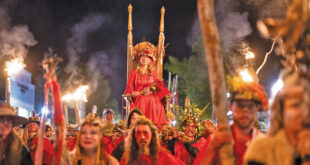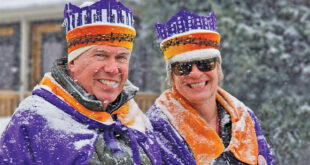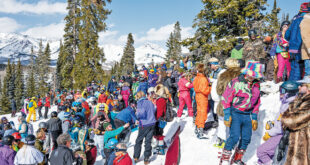Out of Thin Air
Skiing in the Gunnison country has a long history, dating back to the 1880s when the first “extreme” skiing was a means of delivering mail to the mining camps in unbelievably treacherous winter conditions. The most well known of these carriers was Al Johnson, who braved not only wind, rain, sleet and dark of night, but avalanches, steeps and abysmally deep snow between the towns of Crystal and Crested Butte.
As skiing evolved from survival into a sport, there was the Pioneer Ski Mountain on Cement Creek, before CBMR first cranked up their lifts in 1962. Western State College (WSC), now Western State Colorado University (WSCU), used Pioneer for competitive skiing and practice. Later, in the early 1950s, the U.S. Forest Service deemed Pioneer too dangerous and condemned it, which left Western State College without a competition or practice hill.
The WSC Ski Team scoped out Rozman’s Hill and trees were cleared and a tow-rope and ski jump were built for ski practice in downhill, slalom and jumping. During a competition event weekend, spectators’ cars would line the road from the hill all the way back along the highway, and WSC was consistent in delivering topnotch winter athletes.
Sven Wiik, considered the father of Nordic skiing in America, was the U.S. Olympian coach in 1960 and the U.S. FIS coach twice. He set up the Nordic Ski training center in Steamboat Springs and served as the WSC Ski Team coach from 1949 through 1967. Linda Myers was an Olympian before enrolling at WSC in the early 1960s. She went on to represent for WSC in the 1964 Olympics in alpine skiing. It’s interesting to note that Myers trained with the men’s team. Although there was a women’s ski club team, it wasn’t an official varsity team. Wiik requested that Myers be allowed to compete with the NCAA Division I men’s team, but the request was denied by the association. The WSC women’s team became varsity in 1976.
WSC Ski Team members Gary Crawford, a 1988 Olympian, and Kerry Lynch, a 1980 and 1984 Olympian, were both jumping competitors who hailed from the Steamboat Springs Junior Nordic program. Both returned to Steamboat to coach jumping after their time at WSC.
Josh Thompson was a three-time biathlon Olympian coached by Ken MacLennan, who had qualified but did not make the U.S. Army biathlon team in 1960 when he was on the WSC Ski Team. Starting in 1984, Thompson made the Olympic team in biathlon three times and was the first American to win a World Cup event in Nordic. Thompson was named biathlon athlete of the year by the U.S. Olympic committee in 1985. He also represented WSC as a cross-country announcer in the 2002 Olympics.
Last of the Olympians representing WSC before the ski team was abolished was Wendy Wagner, a two-time Olympian Nordic skier, once in 2002 and again in 2006. To her credit were also the titles of NCAA All American Nordic Skier (twice), World Championship Team member (five times), and six-time member of the U.S. Ski Team. When she finished her competition days she became the head cross country skiing coach for the University of Utah.
With a rich history of skiing, more than 20 ski Olympians representing WSC, and a consistently strong NCAA varsity ski team, why did WSC decide to eliminate the program?
Dr. Duane Vandenbusche taught history at WSC for 52 years and was also the WSC head cross country and track and field distance coach for 36 years. He feels, “For me, I thought it was a very poor decision, first, because athletic director Paul Wright was instrumental in getting the NCAA to accept skiing as an intercollegiate sport in the early 1950s. It wasn’t before. Secondly, we are in the Rocky Mountains, we get 300 inches of snow a year. We have a long history of skiing in the Gunnison country. If there was ever a college that ought to have a ski team it was WSC. I mean, these men and women competed all over the U.S. and the world. They are the reason, that is the reason, WSC was put on the map. It was a great recruiting device. People came from all over the nation.”
Dr. Vandenbusche also suggests that the program was waning because it wasn’t funded well, which he attributes to the administration’s not being in favor of skiing and wanting to cut the program. “They had no vision, they didn’t realize what impact that would have on recruiting by dropping the program. And they didn’t understand the tradition of the sport at WSC. It had a big negative impact on a lot of alumni from WSC, not only those who skied on the team, but a lot of other people who attended WSC.
“It was WSC’s calling card,” Vandenbusche claims.
Interim WSCU president Brad Baca thinks the primary reason for cutting the NCAA Varsity Ski program was financial. He says, “When you look at the cost of the ski program, it was the highest and the roster wasn’t very big. Efforts were made but in the end it was financially not feasible. To me, it’s not so much about what we don’t have, it’s about what we do have.”
Three years ago the Mountain Sports Team was created. Baca notes that there are currently nearly 100 students involved in the skiing and snowboarding teams. “These are attractive draws for students. Not only does it attract but we retain these students. Like anything, if you get them engaged in activity, academics, and community, they’ll stay,” Baca feels.
Dave Wiens is the inaugural Mountain Sports director for WSCU. He originally came on board to develop better bike racing competition. Wiens is known most for his six consecutive wins in the Leadville Trail 100 mountain bike race, where he defeated Floyd Landis and Lance Armstrong. “Many of the top cycling colleges have scholarship programs but I felt that even if we had the money to offer top cyclists scholarships, they wouldn’t thrive here because of our winters,” he reasoned.
“Most top-level cyclists want to train year-round and this is very difficult, if not impossible, in Gunnison,” Wiens continues. “I suggested a program for all-season athletes, one that targeted mountain bikers who wanted to compete in the fall, but who then also wanted to put their bikes away and get out the skis and snowboards. I have always felt that embracing winter is a key element of living in this valley.”
Mountain Sports became an umbrella brand for three existing club teams: cycling and freeride and Nordic skiing. Wiens added snowboarding and ramped up the skiercross and park and pipe teams in 2013. That year, Western competed at the United States Collegiate Ski and Snowboard Association (USCSA) nationals in Sun Valley and from nowhere, elbowed their way onto the podium in the disciplines of skiercross, halfpipe, slopestyle and snowboarding. “Our men’s ski team took second overall behind CU while our women’s ski team and our men’s snowboard team were both third overall,” he proudly claims.
Currently, the marquee team at Western is the freeride/big mountain team. “Our home mountain, CBMR, pioneered this discipline of skiing and no college or university has access to the kind of terrain that we have here.”
When asked about the potential for a return of the old ski team, Wiens is optimistic, yet realistic. “As far as the NCAA skiing program returning to Western, I cannot even contemplate that at this point. However, we’re already competing in the USCSA in Freeride and Nordic. It is one of my goals to add the traditional alpine events of slalom and giant slalom to the Mountain Sports program. As an entity, Mountain Sports lives in an area between the NCAA Athletic Department and Club Sports.
Funding is the key issue. Wiens spends most of his time working to add financial resources to the program. “Our current funding comes from a variety of sources, including institutional money, alumni, corporate, CBMR and the Crested Butte Snowsports Foundation. It’s not unusual, it’s the new landscape of college athletics,” Wiens explains.
Dr. Vandenbusche says he’s a big supporter of the Mountain Sports Club. “We needed that and Dave Wiens does a great job. It’s very important, those kids do wonderful things, and it’s a great addition to WSCU, but,” he continues, “I would like to see the restoration of the intercollegiate ski teams of WSCU, both alpine and Nordic, men and women, because it would help our recruitment, and continue a rich tradition of skiing at WSCU and the Gunnison country. It would engender a lot of additional alumni support and I think it would give great publicity to WSCU.”
Wiens points out that competitive skiing has changed dramatically in the last 15 or 20 years and that the Mountain Sports program is a reflection of those changes. “I support and honor the tradition of competitive skiing at Western for sure and I’m confident that we are building a skiing program that our old ski team alums will be proud of, if they aren’t already. I’m willing to look back but I’m not going to stare. Right now, today, we have students who are out there skiing competitively, proudly wearing Western ski team jackets and attending classes here in Gunnison. My only goal is to move the skiing program at Western forward.”
 The Crested Butte News Serving the Gunnison Valley since 1999
The Crested Butte News Serving the Gunnison Valley since 1999




